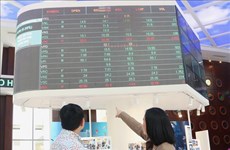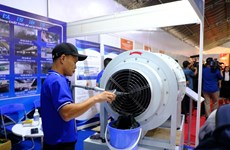India apparel firms seek opportunities
A delegation of Indian apparel and textile trading companies met executives of
Vietnamese companies in HCM City on Dec. 12, seeking trade and
investment opportunities.
A delegation of Indian apparel and textile trading companies under
the Apparel Export Promotion Council of India (AEPC) met executives of
Vietnamese companies in HCM City on Dec. 12, seeking trade and
investment opportunities.
Premal Udani, AEPC chairman, said the delegation wanted to learn about production facilities, productivity in the garment sector, cost advantages in apparel manufacturing, labour policy, and incentives, if any, given by the Government of Vietnam.
This would help open up discussions on collaborations including the establishment of joint ventures, he said.
AEPC is open to an exchange programme under which Vietnamese students can attend courses at the Institute of Apparel Management. It can also offer support for the Vietnam Textile and Apparel Association to train its employees with various training programmes in production technology, computerised pattern making, quality control techniques, merchandising management and other areas, Udani said.
Pham Gia Hung, Director of the Vietnam Textile and Apparel Association’s External Affairs Department, said Vietnam has 3,710 companies in the garment and textile sector, of which 70 percent were producing apparel, while the spinning, weaving and dyeing were not very strong.
Hung said under the industry’s latest five-year development plan until 2015, investment would be increased in raw material production to increase the localisation rate.
The industry will also focus on research and development and human resources training in order to become more competitive, he said. Priority will be given to designing, new product development and the development of supporting services to shift the apparel business from a CM mode (contract manufacturers in which manufacturers are provided with all input materials and designs by foreign buyers) to FOB production or original design manufacturers (ODM), he said.
Hung said building Vietnamese apparel brands was very important to boost the industry’s international profile.
The industry will also focus on restructuring production and relocating factories to minimise pollution risks and take advantage of less labour-intensive areas, he said. /.
Premal Udani, AEPC chairman, said the delegation wanted to learn about production facilities, productivity in the garment sector, cost advantages in apparel manufacturing, labour policy, and incentives, if any, given by the Government of Vietnam.
This would help open up discussions on collaborations including the establishment of joint ventures, he said.
AEPC is open to an exchange programme under which Vietnamese students can attend courses at the Institute of Apparel Management. It can also offer support for the Vietnam Textile and Apparel Association to train its employees with various training programmes in production technology, computerised pattern making, quality control techniques, merchandising management and other areas, Udani said.
Pham Gia Hung, Director of the Vietnam Textile and Apparel Association’s External Affairs Department, said Vietnam has 3,710 companies in the garment and textile sector, of which 70 percent were producing apparel, while the spinning, weaving and dyeing were not very strong.
Hung said under the industry’s latest five-year development plan until 2015, investment would be increased in raw material production to increase the localisation rate.
The industry will also focus on research and development and human resources training in order to become more competitive, he said. Priority will be given to designing, new product development and the development of supporting services to shift the apparel business from a CM mode (contract manufacturers in which manufacturers are provided with all input materials and designs by foreign buyers) to FOB production or original design manufacturers (ODM), he said.
Hung said building Vietnamese apparel brands was very important to boost the industry’s international profile.
The industry will also focus on restructuring production and relocating factories to minimise pollution risks and take advantage of less labour-intensive areas, he said. /.












